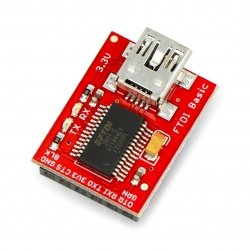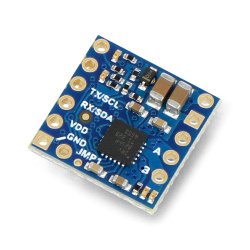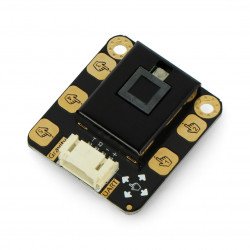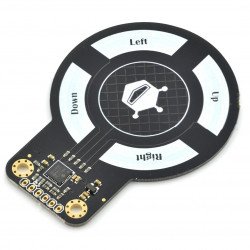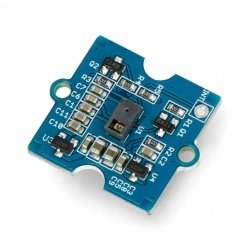The development of consumer electronics, including multimedia devices for playing movies and music, as well as building automation and intelligent installations, have a lot in common. One example of this is a control mode that almost eliminates the classic remotes and pushbutton interfaces, which is control using gestures and physical body movements of the user. Also control panels, which are key elements in most industrial and automotive applications, today are becoming more modern in terms of control technology. As the complexity of control increases and depending on external conditions (including environmental conditions), the traditional interface of the control panel with buttons and switches may prove insufficient, and additionally, make it difficult to control a specific process. One of the solutions to this problem is the use of non-contact sensors that respond to operator gestures. In this role, sensor modules that respond to human movement and gestures will be perfect. The sensors we offer in this category are very easy to use and allow you to build many interesting designs of control devices.
Gesture sensors
APDS-9930 - proximity and light intensity sensor I2C 3.3V
Module with proximity sensor and light intensity sensor, based on a system APDS9930. It detects objects at a distance of up to 100 mm. It has a resolution of 16-bits. It...APDS9960 Proximity, Light, Color and Gesture Sensor - STEMMA QT/Qwiic - Adafruit 3595
The sensor, which can detect simple gestures, light of the surroundings, color and approaching obstacles. The device communicates with a microcontroller via the I2C bus. It...- Reduced price
- SPECIAL OFFERS
Gravity - gesture and touch sensor - UART- DFRobot SEN0285
A sensor module that combines gesture and touch recognition functions. It allows the detection of gestures from a distance of 0 to 30 cm, this distance can be adjusted in the...Gravity - gesture sensor PAJ7620U2 - DFRobot SEN0315
The PAJ7620U2 based gesture sensor can recognize up to 13 different hand gestures at a distance of 20 cm. The module communicates using the popular I2C interface. It is...APDS-9960 RGB sensor and 3,3V I2C gesture detector - SparkFun SEN-12787
Module with sensor that measures the light intensity of the environment, enables the detection of proximity of an object and recognize hand gestures. With this sensor, you can...Grove - Smart IR Gesture Sensor - with IR camera PAG7646J1 - Seeedstudio 101991067
Intelligent Smart IR Gesture Sensor module from Seeedstudio enabling the recognition of over 15 gestures. The manufacturer placed the PAG7646J1 IR camera and the PAG7661QN...Particle Sensor Breakout - MAX30101 - SparkFun SEN-16474
The sensor is based on a system MAX30101 and allows for the determination of the distance, pulse, smoke, and even blinking of an eye. It has 3 LEDs and a very responsive...- Sale
- SPECIAL OFFERS
Fermion - GR10-30 gesture recognition sensor - UART/I2C - DFRobot SEN0543
Fermion - GR10-30 gesture sensor manufactured by DFRobot. Can recognize up to 12 hand gestures - up, down, left, right, forward and backward, clockwise and counterclockwise...DFRobot 3D Gesture Sensor (Mini) For Arduino
Interactive sensor that can recognize gestures in 3D and also track the motion. Supply voltage is from 3.3 V to 5 V, and the detection range is around 5 cm.MU Vision Sensor - sensor for object recognition I2C/UART/WiFi - DFRobot SEN0314
The sensor for object recognition is equipped with a deep learning engine. It has a wide-angle lens and various algorithms to recognize objects such as balls, people, cards,...Gesture and RGB color sensor I2C - APDS-9960 - DFRobot SEN0187
The module based on the APDS-9960 chip allows you to detect gestures made by hand movement and colors from the RGB color palette, as well as ambient light. The module is...Grove - gesture sensor PAJ7620U2 - 5V I2C
Module from the Grove series, is equipped with a gesture sensor PAJ7620U2 with I2C interface. It can recognize 9 basic gestures. It is powered with the voltage of 5 V. It has a...Gravity - GR10-30 gesture sensor - UART, I2C - DFRobot SEN0561
The Gravity GR10-30 gesture sensor module, produced by DFRobot, is a great alternative to classic buttons or touch screens. It can recognize as many as 12 different gestures...See also
- Tilt sensors
- Accelerometers
- Inductive sensors
- Hall effect sensors
- Oxygen sensors
- Optical sensors
- Resistance sensors
- Door sensors
- Piezoelectric sensors
- RPM sensors
- Twilight sensors
- Alarm sensors
- 9DoF IMU sensors
- Pressure sensors
- Air quality sensors
- Sound sensors
- Gas sensors
- Limit switches
- Sensors of light and color
- Magnetic sensors
- Medical sensors
- Pressure sensors
- Sensors odbiciowe
- Distance sensors
- Inductive contactless sensors
- Weather sensors
- Liquid level sensors
- Current sensors
- Flow sensors
- Motion sensors
- Temperature sensors
- PT100 temperature probes
- Humidity sensors
- Fingerprint readers
- Encoders
- Photoresistors
- Phototransistors
- IR receivers
- Magnetometers
- Gyros
- Sensor sets
- Grove modules
- Gravity modules
A wide range of Versatile applications using non-contact gesture control
The first implementations of sensor devices for non-contact control were used to detect an object approaching the sensor and in response to sending a trigger signal to start the appropriate process. Automatic gates, soap dispensers, porch lighting on buildings, hand dryers, and car parking aids use non-contact sensors as an input source. For this purpose, distance sensors are used, which from the side of the electrical diagram resemble toggle switches, as well as gesture sensors that recognize the operator's gesticulation movements in three dimensions and thus allow you to control objects intuitively. Gesture control also allows the user to match the response of the controlled object to the range of motion as seen by the sensor. It is one of the key features in video game systems. We offer you motion sensors that can also work as vibration, tilt, shock or shock sensors. Thanks to their miniature designs (their dimensions start from several millimetres), they are perfect for vehicle security systems. Remember that the most effective alarm system is one you build yourself.
Gesture detection using IR sensors
Non-contact control systems in extensive video game consoles use lasers and special cameras that record the player's movements. Thanks to the ability to detect various simple movements, simple motion sensors have found application in electronics, electric musical instruments and also in the automotive industry. For example, to change a radio station in a non-contact way, you will need to swipe your hand to the left or right in the sensor's field of view. On the other hand, the volume control can be done by bringing the hand closer or away from the sensor. In, among others In such applications, the most technically and cost-effective solution is the use of infrared (IR) light sensors. In one of the simplest shots, IR sensors consist of two infrared light-emitting diodes (emitter) and an infrared receiver placed between them. The radiation from the infrared emitter usually has a highly directional characteristic. When you wave your hand in front of the emitter of the IR sensor, the infrared light reflected from its surface, detected by the IR receiver, will change in intensity, proportional to the movement made - for example, by moving your hand from the left to the right side of the sensor, the amplitude of the signal from the IR emitter will increase and analogously in the opposite direction of hand movement. Then, the IR sensor sends a signal to the microcontroller, which, using the loaded program, analyzes the input data in terms of the speed of the gesture as well as its type and direction, and then, depending on these factors, sends control signals to the appropriate output devices.







































































































































































































































































































































